
Campbelltown is a suburb located on the outskirts of the metropolitan area of Sydney, New South Wales, Australia. It is located in Greater Western Sydney 53 kilometres (33 mi) south-west of the Sydney central business district by road. Campbelltown is the administrative seat of the local government area of the City of Campbelltown. It is also acknowledged on the register of the Geographical Names Board of New South Wales as one of only four cities within the Sydney metropolitan area.

South Western Sydney is a region of the metropolitan area in southwest Sydney, New South Wales, Australia. It is part of the predominantly working class area of Greater Western Sydney. The region lies in the Cumberland Plain.

Thirlmere is a small semi-rural town in the Macarthur Region of Sydney in New South Wales, Australia, in the Wollondilly Shire. Popularly known for its railway origins, the town is located 89 km south west of the Sydney Central Business District. At the 2021 census, Thirlmere had a population of 4,986.

The Division of Hume is an Australian electoral division in the state of New South Wales.

Picton railway station is a heritage-listed railway station located on the Main Southern line in the south-western Sydney suburb of Picton in the Wollondilly Shire local government area of New South Wales, Australia. It was built from 1863 to 1919. It is also known as the Picton Railway Station group. The property was added to the New South Wales State Heritage Register on 2 April 1999. The station opened on 1 July 1869. The station is unusually sited, with southbound journeys actually heading north out of the station before traversing a 225 degree horseshoe curve to again head south, and likewise northbound services heading south before rounding a number of curves to resume their true direction.

Picton is a small town in the Macarthur Region of New South Wales, Australia, in the Wollondilly Shire, in south-western Sydney. The town is located approximately 90 kilometres south-west of the Sydney CBD, close to Camden and Campbelltown. It is also the administrative centre of Wollondilly Shire.

Wollondilly Shire is a periurban local government area, located on the south west fringe of the Greater Sydney area in New South Wales, Australia, parts of which fall into the Macarthur, Blue Mountains and Central Tablelands regions in the state of New South Wales, Australia. Wollondilly is seen as the transition between Regional NSW and the Greater Sydney Region, and is variously categorised as part of both. Wollondilly Shire was created by proclamation in the NSW Government Gazette on 7 March 1906, following the passing of the Local Government (Shires) Act 1905, and amalgamated with the Municipality of Picton on 1 May 1940.
Bargo is a town in the Macarthur Region of Sydney in New South Wales, Australia, in the Wollondilly Shire. It is located approximately halfway between Campbelltown and Bowral, about 100 km south west of the Sydney CBD.

Buxton is a small village in Macarthur Region of Sydney in New South Wales, Australia, in Wollondilly Shire. At the 2021 census, Buxton had a population of 2,071 people. Its name comes from the town of Buxton, Derbyshire.

Douglas Park is a town of the Macarthur Region in New South Wales, Australia in Wollondilly Shire. It is near the Hume Highway, the F5 Freeway and on the Main Southern railway line. Its station is served by NSW TrainLink's Southern Highlands Line. It is about 80 km southwest of Sydney. In 2016, Douglas Park had a population of 1,362.

Tahmoor is a small town in the Macarthur Region of New South Wales, Australia, in Wollondilly Shire.

Wollondilly is an electoral district of the Legislative Assembly in the Australian state of New South Wales. It is currently represented by independent Judy Hannan, who defeated sitting member Nathaniel Smith at the 2023 New South Wales state election.

Appin is a town on the south-west fringe of Sydney in the Macarthur Region in Tharawal country near its boundary with Gandangara country, New South Wales, Australia in Wollondilly Shire. It is situated about 16 kilometres (9.9 mi) south of Campbelltown and 35 kilometres (22 mi) northwest of Wollongong.

Couridjah is a small town in the Macarthur Region of New South Wales, Australia, in Wollondilly Shire. It was previously known officially as "Village of Couridjah". At the 2016 census, Couridjah had a population of 303.

The Oaks is a town in the Macarthur Region of New South Wales, Australia in Wollondilly Shire on the south western edge of the Sydney Basin. The Oaks is located 82 kilometres (51 mi) south-west of Sydney via the Hume Highway, 13 kilometres (8 mi) west of Camden and 290m above sea-level. At the 2016 census, The Oaks and the surrounding area had a population of 2,525.
Phillip John Costa is an Australian politician. He was a Labor Party member of the New South Wales Legislative Assembly from 2007 until 2011, representing the electorate of Wollondilly. He served as Minister for Water and Minister for Corrective Services.

Razorback is a locality and scattered village in the Macarthur Region of New South Wales, Australia, in the Wollondilly Shire. At the 2021 census, the locality had a population of 1,174. It is in between the main Macarthur towns of Picton and Camden.

Wilton is a town of the Macarthur Region of Sydney in New South Wales, Australia in the Wollondilly Shire. It is located around 80 km south west of the Sydney CBD, within close proximity of Cataract Dam. It is an exurb of Greater Sydney under development, which includes the new estate of Bingara Gorge.

Jarvisfield is a heritage-listed former pastoral property and now golf course at Old Hume Highway, Picton, Wollondilly Shire, New South Wales, Australia. It was designed by William Weaver, architect-engineer, and built from 1815 to 1864. It is also known as Wilton. The property is owned by the Wollondilly Shire Council. It was added to the New South Wales State Heritage Register on 2 April 1999.

The Macarthur Conference Rugby League is a senior Rugby league competition in New South Wales, Australia, administered by the New South Wales Rugby League. Formerly known as Group 6 Rugby League, the competition was, until 2019, run under the auspices of the Country Rugby League. The geographical area covered by the former CRL Group 6 takes in much of the Southern Highlands and southern Macarthur regions of New South Wales, extending from Marulan, New South Wales in the south, to Mount Annan/ the M5 in the north and Warragamba in the west.























